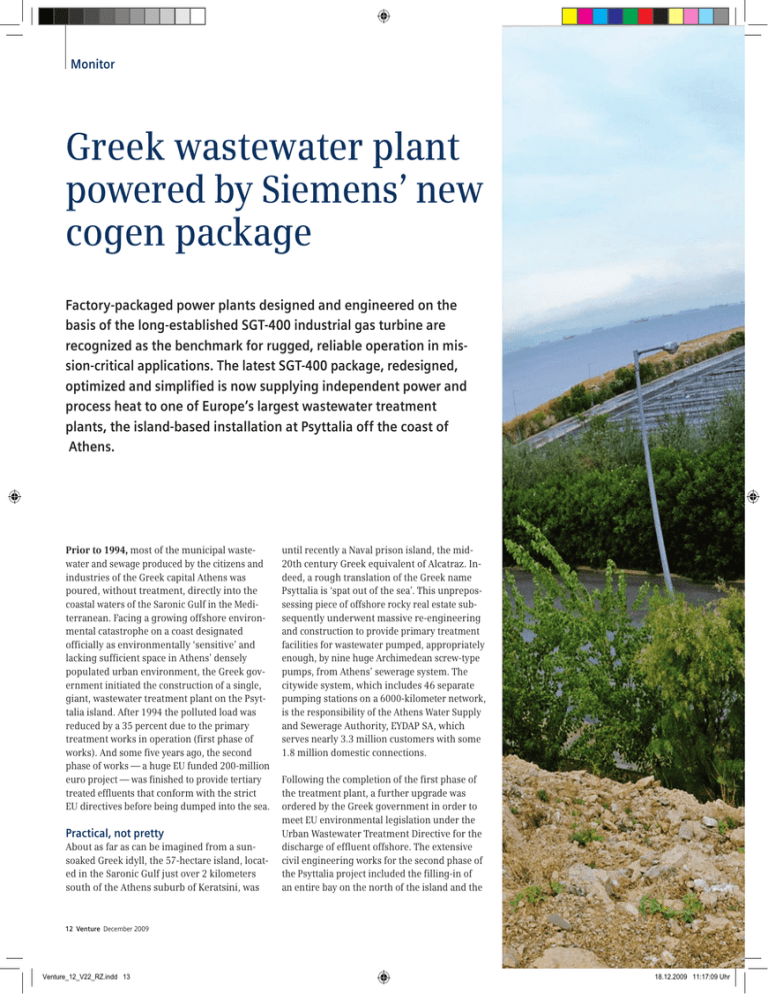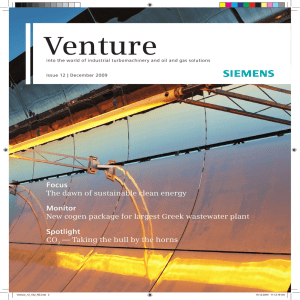Greek wastewater plant powered by Siemens’ new cogen package
advertisement

Monitor Greek wastewater plant powered by Siemens’ new cogen package Factory-packaged power plants designed and engineered on the basis of the long-established SGT-400 industrial gas turbine are recognized as the benchmark for rugged, reliable operation in mission-critical applications. The latest SGT-400 package, redesigned, optimized and simplified is now supplying independent power and process heat to one of Europe’s largest wastewater treatment plants, the island-based installation at Psyttalia off the coast of Athens. Prior to 1994, most of the municipal waste‑ water and sewage produced by the citizens and industries of the Greek capital Athens was poured, without treatment, directly into the coastal waters of the Saronic Gulf in the Mediterranean. Facing a growing offshore environmental catastrophe on a coast designated officially as environmentally ‘sensitive’ and lacking sufficient space in Athens’ densely populated urban environment, the Greek government initiated the construction of a single, giant, wastewater treatment plant on the Psyttalia island. After 1994 the polluted load was reduced by a 35 percent due to the primary treatment works in operation (first phase of works). And some five years ago, the second phase of works — a huge EU funded 200-million euro project — was finished to provide tertiary treated effluents that conform with the strict EU directives before being dumped into the sea. Practical, not pretty About as far as can be imagined from a sunsoaked Greek idyll, the 57-hectare island, located in the Saronic Gulf just over 2 kilometers south of the Athens suburb of Keratsini, was until recently a Naval prison island, the mid20th century Greek equivalent of Alcatraz. Indeed, a rough translation of the Greek name Psyttalia is ‘spat out of the sea’. This unprepossessing piece of offshore rocky real estate sub‑ sequently underwent massive re-engineering and construction to provide primary treatment facilities for wastewater pumped, appropriately enough, by nine huge Archimedean screw-type pumps, from Athens’ sewerage system. The citywide system, which includes 46 separate pumping stations on a 6000-kilometer network, is the responsibility of the Athens Water Supply and Sewerage Authority, EYDAP SA, which serves nearly 3.3 million customers with some 1.8 million domestic connections. Following the completion of the first phase of the treatment plant, a further upgrade was ordered by the Greek government in order to meet EU environmental legislation under the Urban Wastewater Treatment Directive for the discharge of effluent offshore. The extensive civil engineering works for the second phase of the Psyttalia project included the filling-in of an entire bay on the north of the island and the 12 Venture December 2009 Venture_12_V22_RZ.indd 13 18.12.2009 11:17:09 Uhr Monitor Venture_12_V22_RZ.indd 14 18.12.2009 11:17:40 Uhr Monitor The new SGT-400 cogeneration package (left) on Psyttallia Island off Athens. The heat of the gas turbine exhausts is used for sludge drying in the facility to the right. 14 Venture December 2009 Venture_12_V22_RZ.indd 15 18.12.2009 11:17:54 Uhr Monitor With its 12.9 MWe, the SGT-400 package allows the complete wastewater treatment plant to run in independent island mode, should it be necessary. Right: View into the container with the gas turbine's Dry Low Emissions (DLE) burners. excavation of some 4 million cubic meters of rocky ground to allow the installation of 14 huge bio-reactor basins and 64 sedimentation tanks. The upgrade included biological treatment to remove virtually all environmentally harmful organic compounds from the effluent stream and mechanical de-watering of the sludge, which was shipped in bulk for disposal in landfill sites on the mainland. Clean, but expensive Operated and maintained on behalf of EYDAP by Aktor SA, part of Ellaktor the leading Greekbased international contractors group in Joint Venture with Athena SA, also a Greek contractor company, the upgraded Psyttalia plant was completed just prior to Greece’s hosting of the 2004 Olympics and currently can treat an average of 12 cubic meters of wastewater per second, equivalent to 1 million cubic meters per day, meeting all relevant EU environmental requirements. However, shipping some 800 tonnes of dewatered sewage sludge per day from the island for disposal in scarce landfill represented both an environmentally and financially costly solution. Under an additional 40-million euro of EU funding, the Ministry of Public Works commissioned a new sludge-drying plant on the island, fueled by natural gas. In commercial operation since 2007, the plant converts the sludge into a granular product, dried to less than 10 percent water content and supplied to cement industries to be used as a low-calorific value fuel. The cogen solution In the face of on-going hikes in the price of natural gas, the water and sewage authority invited tenders for the construction of an on-site ‘total energy’ plant using gas-turbine-based cogeneration technology, raising efficiency, cutting costs and increasing its commercial competitiveness. The new plant was designed by EYDAP to be capable of not only meeting the thermal load requirements of the sludge drying plant, but also to cover the major part of the electrical-load requirements for the entire island. By capturing the ‘waste’ heat from the turbine’s exhaust gases to substitute the drying plant’s gas-fired heaters, improving fuel efficiency could give significant savings in total operating costs. Also in a future upgrade, the December 2009 Venture 15 Venture_12_V22_RZ.indd 16 18.12.2009 11:18:26 Uhr Monitor cogen plant could allow the treatment plant to operate independently from the grid, along with the back-up and standby power available from five existing generating sets, each rated at 2.4 megawatt (MW). These employ reciprocating engines designed to run on methanerich biogas produced from the wastewater treatment process, with sufficient fuel reserves to give up to 7 hours of standby backup power, enabling critical items of the plant to continue to operate in the event of a failure of the power supplied to the island from the onshore grid. The new independent, dedicated, baseload power plant, using the high-efficiency industrial gas turbine and based on cogeneration tech‑ nology to meet the island’s total energy requirements, could ensure that the Psyttalia treatment facility would operate with maximum sup‑ ply diversity, security and reliability for mission-critical controls, treatment systems and equipment. J/V Aktor-Athena on-stage with Siemens Aktor SA, the construction arm of the parent company Ellaktor, in Joint Venture with Athena SA, bid successfully against some six other domestic and international groups for the EYDAP cogeneration project, with a design based on Siemens’ very latest packaged gas-turbine power generating system, the SGT-400. With an ISO-rated power output of 12.9 MW (electrical) and simple-cycle electrical efficiency of 35 percent, it is regarded as one of the most efficient of its type currently available. The Lincoln-built Siemens machine, designed to operate under baseload conditions, was ideally matched both to the drying plant’s thermal power needs and to the wastewater treatment plant’s total electrical load. Through the use of cutting-edge materials technology, the high exhaust temperature of the gas turbine of more than 550 °C was regarded by Aktor’s engineers as one of the key features of this machine. Capable of generating in excess of 136 tons per hour exhaust gases at these high temperatures, the gas turbine offered a major advantage for the cogeneration application, by enabling the size of the heat exchangers for the sludge-dryer to be kept small, as the available space on the island is limited, whilst achieving a guaranteed thermal efficiency of 46.7 percent. On-spec solution The combustion system for the twin shaft, 2-stage turbine is based on six reverse-flow can-annular combustors and features Siemens’ Dry Low Emissions (DLE) technology. This provides a very significant reduction in exhaust emissions of carbon monoxide and nitrogen oxides, a potentially polluting ‘acid-rain’ gas, to levels far below even the minimum statutory requirements. “We looked at a number of other gas turbine-based packages from competing companies for this combined heat and power application,” commented Pericles Iatrou, Aktor’s project manager at the Psyttalia site, “but although this would be the first time we had actually installed a complete gas turbine-based power plant, we had worked with Siemens in Greece before on previous projects so we had a very high level of confidence in selecting their latest version of the SGT-400, which met our design specifications perfectly.” Iatrou pointed out that a key advantage was also the full compatibility of the new cogen plant’s power-mon‑ itoring and control system with the existing computer-based SCADA network, covering the wastewater treatment automation systems. New approach Energy consumption accounts for some 95 percent of the operational costs of aeration units. As Tom Schjerve, Engineering and Packaging Director for gas turbines at Siemens’ Lincoln factory explained, “The latest SGT-400 package, chosen by our customer J/V Aktor-Athena for their cogen application on Psyttalia, was a bit of a radical departure for us from the usual evolutionary development of our factory-packaged industrial units.” “The original SGT-400 had actually progressed through a continuous 16 Venture December 2009 Venture_12_V22_RZ.indd 17 18.12.2009 11:18:47 Uhr Monitor “We had a very high level of confidence in selecting their latest version of the SGT-400, which met our design specifications perfectly.” Pericles Iatrou, Mechanical-electrical engineer with Aktor series of through-life upgrades. However, this latest version represents a completely new approach to machine development.” Tom went on to explain that the overall re-design was driven by the need to reduce the total time from initial order to final installation, to provide a simplified package with greater standardization and to reduce non-conformance costs by increasing quality. “Increasing numbers of our customers around the world require a significant level of ‘domestic’ content in their installations, so, to meet the demands of global manufacture, our design team drew on the experience of their opposite numbers at other Siemens’ manufacturing plants to create a benchmark design,” said Schjerve. Build-time reduced by 30 percent Using Siemens’ wide experience in meeting customers’ specific requirements in both landbased and offshore industrial applications around the world, including an analysis of all standardized options on the basic skid-mount‑ ed gas-turbine electrical or mechanical drivepackage, the team in Lincoln was able to optimize the range of modular ancillaries. This resulted in a reduction in the total number of available options by more than 60 percent, from an almost bewildering choice for both customer and manufacturer of some 2,500 variations on the ‘standard’ package, down to a more manageable number of 829 design variants, but without compromising the ability of the final packaged unit to meet fully the requirements of the customer and end-user. Because almost all optional modules and an‑ cillary systems can be assembled and factorytested individually as separate systems in parallel with the main build and assembly process, the total build-time of the complete packaged unit has been reduced by 30 percent, the pretested systems also reducing on-site installation time very significantly. Plug and play Working in close co-operation with Siemens’ engineers and utilizing the advantages of the new package to maximum effect, J/V Aktor-Athena was able to reduce the project timescale to a remarkable 18 months, from winning the EYDAP contract to first firing of the completed cogen plant on Psyttalia island. As Pericles Iatrou commented, “You could almost describe your new, simplified package as a ‘Plug and Play’ system!” The good relationship between customer and supplier also helped to ensure that the power plant was not only supplied on time and installed quickly and easily, but that the installation itself was synchronized with the construction of all critical infrastructure and auxiliary systems. Just one week following completion of the new cogeneration plant, surplus electrical power was fed into the grid network. Keeping it clean Now up and running, supplying baseload power to the treatment plant’s facilities and both electricity and heat to operate the sludge-drying plant, Psyttalia’s SGT-400 packaged cogen‑ eration plant is currently operating at around 75 percent full capacity, and helping the Greek sewage and water authority to keep its Mediterranean coastline clean. December 2009 Venture 17 Venture_12_V22_RZ.indd 18 18.12.2009 11:19:24 Uhr





